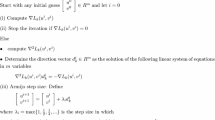Abstract
In this paper, a novel unconstrained convex minimization problem formulation for the Lagrangian dual of the recently introduced twin support vector machine (TWSVM) in simpler form is proposed for constructing binary classifiers. Since the objective functions of the modified minimization problems contain non-smooth ‘plus’ function, we solve them by Newton iterative method either by considering their generalized Hessian matrices or replacing the ‘plus’ function by a smooth approximation function. Numerical experiments were performed on a number of interesting real-world benchmark data sets. Computational results clearly illustrates the effectiveness and the applicability of the proposed approach as comparable or better generalization performance with faster learning speed is obtained in comparison with SVM, least squares TWSVM (LS-TWSVM) and TWSVM.
Similar content being viewed by others
References
Balasundaram S, Gupta D (2014) Training Lagrangian twin support vector regression via unconstrained convex minimization. Knowl-Based Syst 59:85–96
Cortes C, Vapnik V N (1995) Support vector networks. Mach Learn 20:273–297
Cristianini N, Shawe-Taylor J (2000) An introduction to support vector machines and other kernel based learning method. Cambridge University Press, Cambridge
Demsar J (2006) Statistical comparisons of classifiers over multiple data sets. J Mach Learn Res 7:1–30
Fung G, Mangasarian OL (2003) Finite Newton method for Lagrangian support vector machine. Neurocomputing 55:39–55
Golub GH, Van Loan CF (1996) Matrix computations, 3rd ed., The Johns Hopkins University Press
Guyon I, Weston J, Barnhill S, Vapnik V (2002) Gene selection for cancer classification using support vector machine. Mach Learn 46:389–422
Hiriart-Urruty J -B, Strodiot J J, Nguyen V H (1984) Generalized Hessian matrix and second-order optimality conditions for problems with C 1,1 data. Appl Math Optim 11:43–56
Jayadeva K R, Chandra S (2007) Twin support vector machines for pattern classification. IEEE Trans Pattern Anal Mach Intell 29(5):905–910
Joachims T, Ndellec C, Rouveriol (1998) Text categorization with support vector machines: learning with many relevant features. In: European conference on machine learning, no.10, Chemnitz, Germany, pp 137–142
Kumar M A, Gopal M (2009) Least squares twin support vector machines for pattern classification. Expert Syst Appl 36:7535–7543
Kumar M A, Gopal M (2008) Application of smoothing technique on twin support vector machines. Pattern Recogn Lett 29:1842–1848
Lee Y J, Mangasarian O L (2001) SSVM: A smooth support vector machine for classification. Comput Optim Appl 20(1):5–22
Mangasarian O L (2002) A finite Newton method for classification. Optimization Methods and Software 17:913–929
Mangasarian O L, Musicant D R (2001) Lagrangian support vector machines. J Mach Learn Res 1:161–177
Mangasarian O L, Wild E W (2006) Multisurface proximal support vector classification via generalized eigenvalues. IEEE Trans Pattern Anal Mach Intell 28(1):69–74
Murphy P M, Aha D W (1992) UCI Repository of machine learning databases. University of California, Irvine. http://www.ics.uci.edu/~mlearn
Osuna E, Freund R, Girosi F (1997) Training support vector machines: an application to face detection. In: Proceedings of Computer Vision and Pattern Recognition, pp 130–136
Platt J (1999) Fast training of support vector machines using sequential minimal optimization. In: Scholkopf B, Burges CJC, Smola AJ (Ed.), Advances in kernel methods- support vector learning, MIT press, Cambridge, MA, pp 185–208
Peng X (2011) TPMSVM: A novel twin parametric-margin support vector machine for pattern recognition. Pattern Recogn 44(10-11):2678–2692
Peng X (2010) TSVR: An efficient twin support vector machine for regression. Neural Netw 23(3):365–372
Rockafellar R T (1974) Conjugate duality and optimization. SIAM, Philadelphia
Shao Y, Zhang C, Wang X, Deng N (2011) Improvements on twin support vector machines. IEEE Trans Neural Netw 22(6):962–968
Suykens J A K, Vandewalle J (1999) Least squares support vector machine classifiers. Neural Process Lett 9(3):293–300
Vapnik VN (2000) The nature of statistical learning theory, 2nd ed. Springer, New York
Zhou S, Liu H, Zhou L, Ye F (2007) Semi-smooth Newton support vector machine. Pattern Recogn Lett 28:2054–2062
Acknowledgments
The authors are thankful to the anonymous reviewers for their comments.
Author information
Authors and Affiliations
Corresponding author
Rights and permissions
About this article
Cite this article
Balasundaram, S., Gupta, D. & Prasad, S.C. A new approach for training Lagrangian twin support vector machine via unconstrained convex minimization. Appl Intell 46, 124–134 (2017). https://doi.org/10.1007/s10489-016-0809-8
Published:
Issue Date:
DOI: https://doi.org/10.1007/s10489-016-0809-8




